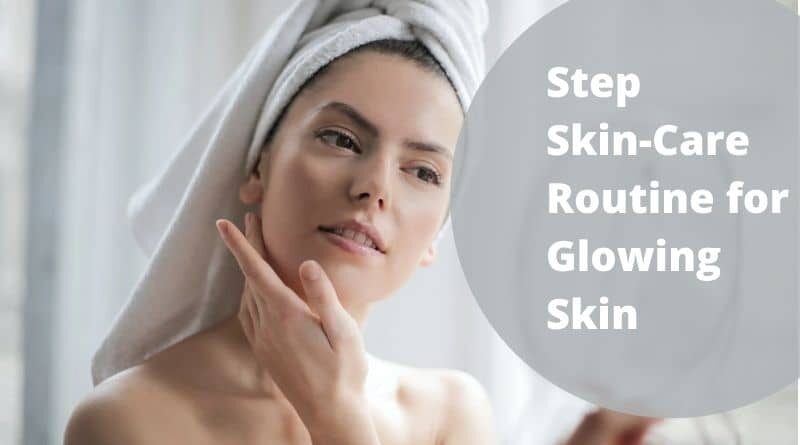Want Glowing Skin? Try This 6-Step Skin-Care Routine
Picture glowing skin. If the image in your head is anything like the upwards of 11 million Instagram images using the hashtag, then it’s likely well hydrated, even-toned, and bouncing light at every angle. But with so many products out there—seriously, so. many. products.—how do you achieve a complexion that Instagram proves possible day after day?
It’s actually not as difficult as it may seem. By adding the proper skin care into your regimen and by streamlining your routine into a few simple (but essential!) steps, you can begin to address common skin conditions like acne, hyperpigmentation, dryness, redness, and leave skin glowing.
Table of Contents
6-Step Skin-Care Routine for Glowing Skin
If you’re ready to get going, keep scrolling for the details in six simple steps.
1. Cleanse Your Skin with a Gentle Cleanser and Pat Dry
Most dermatologists recommend cleansing your skin twice a day: once in the morning when you wake up and once at night before you go to bed. You’ll want to reach for a gentle cleanser that doesn’t use soap as its key ingredient but instead taps milder surfactants (another word for cleansing agents), like those sourced from coconuts.
The best cleanser for you depends on your skin type and how you want your skin to feel post-wash. Those with acne may want to reach for a cleanser with benzoyl peroxide or salicylic acid as an active ingredient, which studies have shown can help address breakouts. Gel or lightweight, foamy cleansers tend to be good options for people with oily complexions because they have more surfactants, which can help break through oil, sweat, and dirt in a single wash.
People with sensitive skin should choose a micellar cleanser, which works to attract oil and dirt and wash them away using micelles, and avoiding harsh cleansing agents. Those with dry skin often benefit from grabbing a creamy or oil-based cleanser, which dissolves dirt and grime from the skin while adding hydration back to it.
Once you’ve found the right cleanser for your skin type, take a quarter-sized dollop, apply it to your skin, and wash thoroughly for about 30 seconds to a minute with lukewarm water. After that, you’ll want to make sure all of the product is removed, and—here’s the important part—you’ll want to pat your skin dry with a towel. Rubbing with an abrasive cloth can disrupt or damage your skin barrier, leading to problems for you down the line.
Read: How to Improve the Skin Condition
2. Exfoliate Your Skin to Remove Dead Cells
Exfoliating is one of the most important things you can do to achieve healthy, glowing skin. As dead skin cells collect on the top of your complexion, they form a barrier that keeps the ingredients in your products from fully sinking in to do their job. By removing these dead skin cells, you can get more out of the products you’re investing in because the products will penetrate deeper and reach skin cells that are still active.
There are two main types of exfoliation: physical and chemical:
Physical exfoliants: These are scrubs, brushes, or even wet washcloths that mechanically lift the dead skin cells with your force.
Chemical exfoliants: These are things like alpha-hydroxy acids, beta-hydroxy acids, or enzymes, which work to dissolve the glue between the top layer of skin cells so that they’re able to dissolve and wash down the drain.
3. Use a Serum for Your Skin’s Needs
A serum tends to be the most potent step in your routine because these products contain the most concentrated “active ingredients,” or the types of ingredients in products that help you really see results. Depending on what your skin concerns are, you may want to look for products that have the following in them:
Retinol: The most studied—and recommended ingredient—from dermatologists is a vitamin A derivative that can help smooth fine lines and wrinkles. It’s known for flipping on the collagen pumps within the skin, which helps to smooth fine lines and wrinkles. Simultaneously, retinol speeds up the cell turnover in the skin, which helps to usher away breakouts and dull skin quickly. While some people find it drying, there are many types of retinol to choose from.
Hyaluronic acid: Known for holding up to 100 times its weight in water, hyaluronic acid or HA is a humectant that naturally occurs in your skin. Over a lifespan, HA depletes and it can be helpful to apply it topically to supplement hydration. Look for a serum that has multiple weights of HA molecules, because they’ll sit at different levels of the skin’s structure to offer the maximum amount of hydration and plumping for your skin.
Vitamin C: One of the most potent antioxidants on the market, vitamin C helps to fend off free radicals or unbound electrons that scavenge and damage skin in many ways. Adding a topical vitamin C to your skin-care routine can help to brighten and repair the damage that occurs over time.
Read: Best Treatments for Aging Skin
4. Use a Lightweight Moisturizer
After exfoliating your skin and applying a serum, you’re going to want to make sure that your complexion is moisturized using a light lotion. Some moisturizers can feel thick or heavy, so look for products that say they’re a gel or milk on the package. Some common ingredients to be on the lookout for:
Ceramides: These fatty lipids comprise most of the skin barrier, but as your skin becomes dried out, it can become compromised. By replenishing them topically, you can strengthen your skin barrier and help it retain moisture over time.
Glycerin: As a humectant, glycerin helps pull moisture deeper into the skin. If you want to make sure that your skin is hydrated around the clock, check for this ingredient on a skin-care label.
Squalane: One of the great multi-tasking ingredients, squalane helps to replenish moisture within the skin, while also functioning as an antioxidant to help neutralize free radicals on the go. Look for it in your moistuizer if you want an ingredient that does it all.
5. Apply Sunscreen for Protection Against UV Rays
For additional protection, it’s important to apply sunscreen every day before going outside. Choose a sunscreen that has an SPF of 30 or higher and make sure to reapply it every two hours, especially if you’re going to be spending time in the sun.
If you’re not sure which sunscreen to choose, here’s a quick rundown of the two main types of sunscreen on the market today.
Physical blockers: Sunblocks contain ingredients like zinc oxide or titanium dioxide. Think of them like an umbrella: They sit on top of the skin to shield rays from entering your complexion. While this might sound ideal, a lot of these formulas can be a bit chalky feeling or leave a white cast on the skin.
Chemical blockers: Sunscreens, on the contrary, are meant to sink into the skin and help to filter out rays through a heat-releasing chemical reaction. Think of these activities like a sponge that helps to absorb the rays and deal with them in your skin. Look for avobenzone, octinoxate, octocrylene, and octisalate on the package if you prefer a chemical blocker.
6. Mask Your Skin at Night
To give your skin an extra boost of hydration while you sleep, try using a face mask. Depending on your skin type and your skin’s needs, you can supplement with hydration, brightening ingredients, or acne fighters.
Before bedtime, place a generous amount on your skin, then let it sit overnight. In the morning rinse your skin clean with warm water to remove any remaining residue that might have settled into wrinkles or fine lines.
To Sum It Up
While it may seem complicated to get glowing skin every morning, with a simplified, yet targeted routine, it can be a reality. The most important thing about any regimen is consistency, so take care to commit to a skin-care routine to see how it impacts your complexion over time.
And also remember that your lifestyle also plays a big role in how your skin appears, so work to limit stress, cut out foods that cause inflammation like sugar, and get outside to get your blood pumping with walks. That #glowingskin is yours in no time.
Recommended Articles:
Choose the Right Cleanser for Your Skin Type








